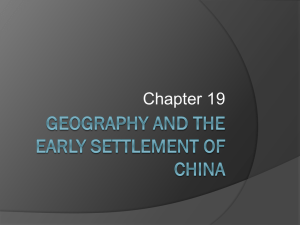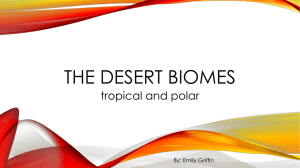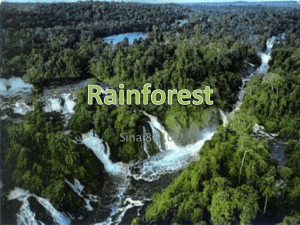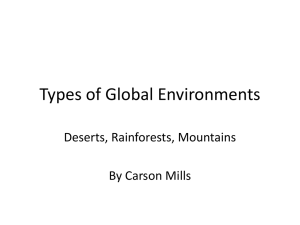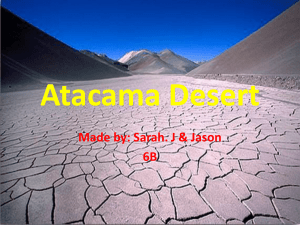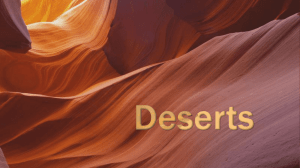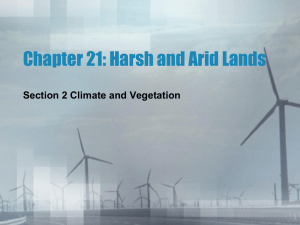What Is a Desert?
advertisement
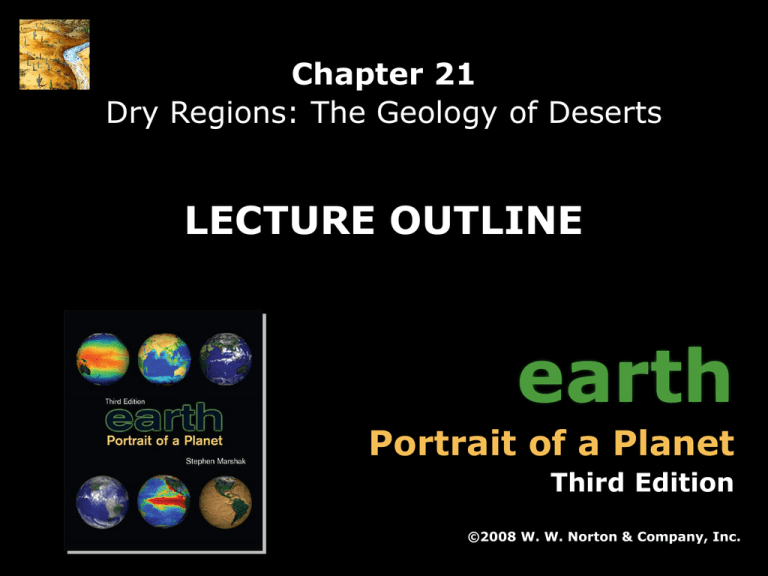
Chapter 21 Dry Regions: The Geology of Deserts LECTURE OUTLINE earth Portrait of a Planet Third Edition ©2008 W. W. Norton & Company, Inc. Earth: Portrait of a Planet, 3rd edition, by Stephen Marshak Chapter 21: Dry Regions: The Geology of Deserts Dry Regions: The Geology of Deserts Prepared by Ronald Parker Earlham College Department of Geosciences Richmond, Indiana Deserts Deserts cover ~ 25% of land surfaces. The primary control on deserts? Plate tectonics! Unique and lovely, deserts are characterized by… Extreme dryness. They may be hot or cold. Specialized ecosystems and low human populations. Unique geologic processes. Earth: Portrait of a Planet, 3rd edition, by Stephen Marshak Chapter 21: Dry Regions: The Geology of Deserts What Is a Desert? Land that is so extremely arid, that… Evaporation prevents permanent surface water. Vegetation covers less than 15% of its surface. Annual rainfall amounts to less than 10” (25 cm). Desert types exist in both hot and cold climates. Earth: Portrait of a Planet, 3rd edition, by Stephen Marshak Chapter 21: Dry Regions: The Geology of Deserts Hot vs. Cold Deserts Hot deserts. Low latitudes. Low elevations. Far from oceans. Earth: Portrait of a Planet, 3rd edition, by Stephen Marshak Cold deserts. High latitudes. High elevations. Near cold ocean currents. Chapter 21: Dry Regions: The Geology of Deserts Desert Features Desert land surfaces often include… Exposed bedrock. Accumulated clasts. Unweathered sediment. Precipitated salt. Windblown sand. Earth: Portrait of a Planet, 3rd edition, by Stephen Marshak Chapter 21: Dry Regions: The Geology of Deserts Types of Deserts 5 types – With distinctive landscapes and biota. Subtropical deserts (Sahara, Arabian, Kalahari). Rain shadow deserts (Eastern Oregon). Coastal deserts (Atacama). Continental interiors (Gobi). Polar deserts (Antarctica). Earth: Portrait of a Planet, 3rd edition, by Stephen Marshak Chapter 21: Dry Regions: The Geology of Deserts Subtropical Deserts Due to patterns of atmospheric convection. Equator – 0o latitude. Solar energy evaporates water, which rises as hot, moist air. Rising air cools and expands, forming abundant rain. This air, stripped of moisture, flows to the N and S. Subtropics – 20o- 30o N & S. Sinking dry air wicks water. Landscape below dries. Earth’s largest deserts. Earth: Portrait of a Planet, 3rd edition, by Stephen Marshak Chapter 21: Dry Regions: The Geology of Deserts Subtropical Deserts Found at 20 to 30o N and S latitude across time. African deserts bracket the equator. Sahara & Arabian to the north. Rainforest straddling equator. Namib & Kalahari to the south. Earth: Portrait of a Planet, 3rd edition, by Stephen Marshak Chapter 21: Dry Regions: The Geology of Deserts Rainshadow Deserts Moist ocean winds are driven over mountains. Windward air is forced to rise, expand, and cool. Moisture condenses, becomes rain, and creates a rain forest. Leeward air, stripped of moisture, sinks and drinks. Sinking air warms, compresses, and sucks water out of land. Earth: Portrait of a Planet, 3rd edition, by Stephen Marshak Chapter 21: Dry Regions: The Geology of Deserts Coastal Deserts Cool air over cold ocean water holds little moisture. This air absorbs moisture when it interacts with land. The Atacama desert (Peru) is the driest place on Earth. Earth: Portrait of a Planet, 3rd edition, by Stephen Marshak Chapter 21: Dry Regions: The Geology of Deserts Interior Deserts Air loses moisture as it crosses continents. Land far from ocean moisture can be arid. The Gobi desert in Mongolia is a prime example. Earth: Portrait of a Planet, 3rd edition, by Stephen Marshak Chapter 21: Dry Regions: The Geology of Deserts Polar Deserts Above 66º N and S latitude there is little moisture. Air circulation carries dry air to polar regions. It is so cold that the air can’t hold moisture. Earth: Portrait of a Planet, 3rd edition, by Stephen Marshak Chapter 21: Dry Regions: The Geology of Deserts Desert Processes Deserts are characterized by special processes. Erosion by water and wind. Weathering. Soil formation. Deposition. These processes result in unique landscapes. Earth: Portrait of a Planet, 3rd edition, by Stephen Marshak Chapter 21: Dry Regions: The Geology of Deserts Weathering Physical weathering dominates. Rare chemical weathering leaches ions. Evaporation salts both break and cement grains. Earth: Portrait of a Planet, 3rd edition, by Stephen Marshak Chapter 21: Dry Regions: The Geology of Deserts Desert Varnish Exposed surfaces develop desert varnish. Dark surface coating of iron and manganese oxides. Forms very slowly by bacterial activity, dust, and water. Native Americans left petroglyphs in desert varnish. Earth: Portrait of a Planet, 3rd edition, by Stephen Marshak Chapter 21: Dry Regions: The Geology of Deserts Desert Soils Desert soils are thin, with poorly defined horizons. They usually are colored like the bedrock nearby. Trace elements orchestrate wide color variations. Earth: Portrait of a Planet, 3rd edition, by Stephen Marshak Chapter 21: Dry Regions: The Geology of Deserts Water Erosion Though rare, water shapes landscapes. Lack of roots magnifies sediment erosion and transport. Torrential rains generate dangerous flash floods. Rapid flow of thick, muddy, and viscous water. Flash floods quickly infiltrate dry stream beds. Earth: Portrait of a Planet, 3rd edition, by Stephen Marshak Chapter 21: Dry Regions: The Geology of Deserts Wind Erosion and Transport Sparsely vegetated ground is scoured by wind. Sand and silt-sized sediment is lifted and moved. Surface load – Grains moved in contact with land surface. Saltation – Sand skipped and bounced by grain impact. Suspended load – Sediment carried in the air. High winds can carry dust across entire oceans. Earth: Portrait of a Planet, 3rd edition, by Stephen Marshak Chapter 21: Dry Regions: The Geology of Deserts Wind Erosion and Transport Coarse clasts cannot be lifted and moved by wind. Lag deposits form when finer sediment is removed. Form desert pavement, a surface layer of stones. Desert pavement is resistant to erosion. Often coated with desert varnish. Earth: Portrait of a Planet, 3rd edition, by Stephen Marshak Chapter 21: Dry Regions: The Geology of Deserts Wind Erosion and Transport Grains in wind often “sandblast” exposed surfaces. Ventifacts - Stones with wind-faceted upper surfaces. Yardangs – Wind-sculpted bedrock. Earth: Portrait of a Planet, 3rd edition, by Stephen Marshak Chapter 21: Dry Regions: The Geology of Deserts Wind Erosion and Transport Deflation – Lowering the land surface via erosion. Concentrated wind erosion creates a blowout. Desert processes are clearly operating on Mars. Earth: Portrait of a Planet, 3rd edition, by Stephen Marshak Chapter 21: Dry Regions: The Geology of Deserts Desert Deposition Desert sediments accumulate in many settings. Erosional debris accumulates near source areas. Talus aprons, at the angle of repose, collect cliff debris. Rock blocks have shapes determined by jointing. Earth: Portrait of a Planet, 3rd edition, by Stephen Marshak Chapter 21: Dry Regions: The Geology of Deserts Desert Deposition Alluvial fans – Conical accumulations of sediment. Water exiting a canyon spreads out and drops sediment. Alluvial fans grow outward from source over time. Sediment characteristics depend on fan position. Near the source channel sediments are coarse. Sediment grains become finer away from source. Earth: Portrait of a Planet, 3rd edition, by Stephen Marshak Chapter 21: Dry Regions: The Geology of Deserts Desert Deposition Playas – Desert lakes that have no outlet streams. Internal drainage collects water from flash floods. Dissolved solids crystallize out as water evaporates. Halite, gypsum, borax. Earth: Portrait of a Planet, 3rd edition, by Stephen Marshak Chapter 21: Dry Regions: The Geology of Deserts Desert Processes Wind carries two types of sediment load. Surface load – Coarser sand-sized particles. Suspended load – Finer-grained silt-sized “dust.” Sand forms dunes inside deserts; dust forms loess adjacent (and downwind of) deserts. Earth: Portrait of a Planet, 3rd edition, by Stephen Marshak Chapter 21: Dry Regions: The Geology of Deserts Desert Landscapes Deserts exhibit a diverse set of landscape styles. These reflect a complex interplay of erosional and depositional processes over long time spans. Earth: Portrait of a Planet, 3rd edition, by Stephen Marshak Chapter 21: Dry Regions: The Geology of Deserts Desert Landscapes Cliffs and mesas – Bedrock controls landforms. Bedrock exposed along cliffs breaks away along joints. Cliff retreat in flat rocks creates plateaus, then mesas… Then buttes and, finally, chimneys. Earth: Portrait of a Planet, 3rd edition, by Stephen Marshak Chapter 21: Dry Regions: The Geology of Deserts Desert Landscapes Cliffs and mesas – Weathering dictates appearance. Resistant – Form steep cliffs as thick as the rock unit. Weak – Weather to form slopes at the angle of repose. Earth: Portrait of a Planet, 3rd edition, by Stephen Marshak Chapter 21: Dry Regions: The Geology of Deserts Desert Landscapes Cliffs and mesas – Structure governs landforms. Nonhorizontal bedding produces elongate linear ridges. Cuesta – Steep joint-controlled cliff; less-steep dip slope. Hogback – Steeply dipping beds create a symmetric ridge. Inselberg – Eroded remnant of almost-complete cliff retreat. Earth: Portrait of a Planet, 3rd edition, by Stephen Marshak Chapter 21: Dry Regions: The Geology of Deserts Desert Landscapes Stony plains – Sloping, gravelly alluvial fans. Pediments – Ramplike surfaces that slope up toward a mountain front. Earth: Portrait of a Planet, 3rd edition, by Stephen Marshak Chapter 21: Dry Regions: The Geology of Deserts Desert Landscapes Dunes – Windblown accumulations of sand. Sand carried by wind accumulates around an obstacle. Over time, a dune grows and begins to move downwind. Dunes generate enormous crossbeds. Earth: Portrait of a Planet, 3rd edition, by Stephen Marshak Chapter 21: Dry Regions: The Geology of Deserts Desert Landscapes Dunes – Windblown accumulations of sand. Many types; actual dune form depends on variation in… Wind – Velocity and consistency of direction. Sediment supply – Is sand scarce or abundant? Dune Wind Sand Barchan Steady 1 direction Scarce Star Steady Changing directions Scarce Transverse Steady, moderate 1 direction Plentiful Parabolic Steady, strong 1 direction Plentiful Longitudinal Steady, strong 1 direction Abundant Earth: Portrait of a Planet, 3rd edition, by Stephen Marshak Chapter 21: Dry Regions: The Geology of Deserts Desert Landscapes Dunes – Windblown accumulations of sand. Gigantic oceans of sand (ergs) develop in some deserts. Arabian peninsula. Namibia. Ergs existed in the past. Permian. Jurassic. Earth: Portrait of a Planet, 3rd edition, by Stephen Marshak Chapter 21: Dry Regions: The Geology of Deserts Desert Life Desert organisms are adapted to harsh conditions. Dessication. Temperature extremes. Earth: Portrait of a Planet, 3rd edition, by Stephen Marshak Chapter 21: Dry Regions: The Geology of Deserts Desert Problems Desertification – Aridification of nondesert areas. Human activity expands desert areas. Case study: the Aral Sea. Earth: Portrait of a Planet, 3rd edition, by Stephen Marshak Chapter 21: Dry Regions: The Geology of Deserts Desert Problems Desertification is caused by… Overpopulation. Overgrazing. Careless agriculture. Diversion of water supplies. Desertification leads to famine. Earth: Portrait of a Planet, 3rd edition, by Stephen Marshak Chapter 21: Dry Regions: The Geology of Deserts Desert Problems Desertification facilitates large dust storms that... Cross entire ocean basins. Carry disease organisms. Earth: Portrait of a Planet, 3rd edition, by Stephen Marshak Chapter 21: Dry Regions: The Geology of Deserts This concludes the Chapter 21 Dry Regions: The Geology of Deserts LECTURE OUTLINE earth Portrait of a Planet Third Edition ©2008 W. W. Norton & Company, Inc. Earth: Portrait of a Planet, 3rd edition, by Stephen Marshak Chapter 21: Dry Regions: The Geology of Deserts
